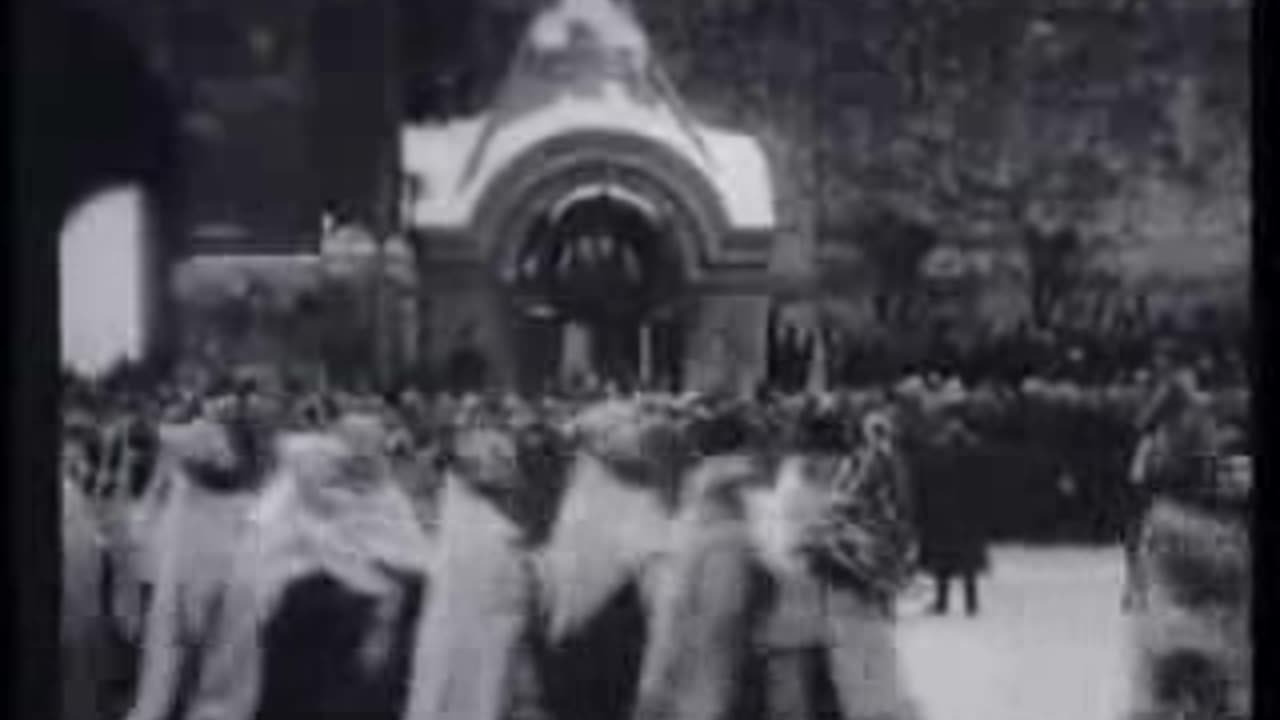Premium Only Content

P. D. Ouspensky - In search of the miraculous
About a Book, that is a personal account of Ouspensky’s years with Gurdjieff, and the ideas of Gurdjieff are presented to some extent in their chronological sequence against the background of the conditions of life which Gurdjieff created for his pupils during the chaos and upheaval of pre-revolutionary Russia. In addition to being a faithful presentation of major aspects of the Gurdjieff teaching, the book thereby also provides much material about the life of Gurdjieff and the early history of what has now become known as “the work.”
The book’s form also allows Ouspensky to communicate to the reader what he clearly considers to be the necessary emotional correlates of these ideas. This is done with refreshing honesty and extraordinary skill—and in a variety of ways—often through Ouspensky’s describing the difficulties he and others encountered in understanding an idea, or the shock when understanding finally appeared and, often, the sense of joy or urgency when realizing this was the great knowledge, the miraculous, of which one had dreamed, but that the demands it made upon the seeker were correspondingly awesome.
Great care is taken throughout the book to characterize the master-pupil relationship between Gurdjieff and his circle. The resulting picture of Gurdjieff is of a man obviously possessing immense wisdom and personal power, capable at once of painfully stripping away the pupil’s “mask” while carefully guiding him through the emotional and bodily experiences necessary for the process of deep learning. The information and speculations which Ouspensky offers about the sources of Gurdjieff’s knowledge and about his motivations for acting as he did in various situations, rather than satisfying the reader’s curiosity about Gurdjieff, communicate instead the impression of an indecipherable man, doubtless one of the most enigmatic men of the twentieth century.
Finally, the form of the book allows Ouspensky to present the Gurdjieff ideas in a specific psychological sequence and in carefully selected juxtapositions without calling this strategy to the attention of the reader.
As for the contents of the book, it touches on nothing less than the whole of the vast Gurdjieffian philosophy, cosmology, psychology, and guidelines for living. Although the book’s subtitle, “Fragments of an Unknown Teaching,” is presumably meant to indicate that the connectedness between all the various ideas cannot be made intellectually explicit, but must be discovered through experience, and although from a certain point of view it must still be considered a preliminary treatment, nevertheless the impression of an awesomely comprehensive system of ideas is inescapable. What follows is necessarily an extremely truncated abstract.
Abstract
The author begins by describing his first meeting with Gurdjieff shortly after he, Ouspensky, had returned from India in search of a school of higher knowledge. To Ouspensky’s surprise, this man Gurdjieff, whom he is meeting in his native Russia, seems to possess that knowledge which Ouspensky had twice traveled around the world seeking. Moreover, Gurdjieff has organized a group, structured along unfamiliar but intriguing principles, to study this knowledge. There are esoteric schools, Gurdjieff tells him, but the first thing to realize is that a very special sort of knowledge is needed, even among esoteric teachings, in order for a man to have results corresponding to his full possibilities. And the first thing necessary is for a man to see how far in fact he is from these possibilities. Man, says Gurdjieff, is actually not a man, he is a machine. All the attributes of man—freedom, understanding, love, creativity—are not his until he works for them. Man can cease to be a machine; he can become conscious. But first he must see his complete mechanicalness. This is extremely difficult, and very few can wish for or bear to see the truth about themselves.
Conversations with Gurdjieff continue until gradually a group forms itself for the sake of studying and putting the ideas into practice. Man’s possibilities are very great, Gurdjieff tells them, greater than they can imagine. It is, he says, a question of actually forming within oneself something tangibly permanent, something higher and more real than the physical body which is all there is of ordinary man, no matter what he may imagine of himself. Gurdjieff presents to Ouspensky’s group the teaching about the soul that can be developed in man, and this is juxtaposed to Gurdjieff’s teaching about the aim of his work—namely, the development of being in man. Man is not; he is only a fragmented and veiled collection of personages masquerading as a real self. The real self must be formed through work, through a specific form of suffering, a discipline. Such discipline lies at the heart of the great traditions, but this path does not exist in the modern, Western world. At the same time, there can be several forms of this discipline, some quick and some slow, some suitable for modern man, some unsuitable.
Gurdjieff describes his teaching as representing the fourth way, not the way of bodily struggle (the way of the fakir), nor the way of purification of the emotions (the way of the monk), nor the way of purification of the mind (the way of the yogi). The fourth way works on all aspects of man at the same time, and requires no renunciation or belief. It can be and indeed must be practiced in the midst of ordinary life conditions. It is thus easier and faster, but also, in another sense, far more difficult than the traditionally recognized methods of self-development. The difficulty consists in its inherent newness—it can never be a culturally familiar form, but must always move at a different tempo from human culture or the normally recognized functions of reason; because it is the rapid path, it puts constant pressure upon the individual for seeing the truth about himself.
Gurdjieff also speaks about the absence of unity in another, more fundamental way which also points to the meaning, in this teaching, of man’s potentially developed unity. The human structure, Ouspensky and his group learn, consists of several minds. These minds, or centers of perception, are the real structural elements of human nature and any attempts to bring man to unity that do not understand these centers are bound to fail.
At various points throughout the book, the subject of the centers (basically, the thinking center, the emotional center, and the moving-instinctive center), is treated and developed more and more until it becomes clear that the idea of the three centers in man is one of the most central ideas in the whole of the Gurdjieffian system. Man’s confusion, his lack of unity, his unnecessary suffering, his immorality—in fact everything that characterizes the sorrow of the human condition—come about because these centers of perception are wrongly related, wrongly functioning, and because man does not see or care to know this about himself.
A characteristic of In Search of the Miraculous, which from all other accounts doubtless reflects the Gurdjieff teaching accurately, is the unique mingling of cosmological ideas with teachings concerning psychology. Ouspensky now begins the long, powerful portrayal of Gurdjieff’s teachings about the origin and structure of the universe, the laws behind the appearances, laws and forces that govern everything from the creation of galaxies to the movements of atoms to the energy transactions within the human organism.
The two basic laws of reality are the law of three forces and the law of the octave. Every phenomenon in the universe is inevitably the manifestation of three forces; and every process takes place according to a structure symbolized by the familiar seven-tone musical scale, with steps either upward or downward and with junctures, or intervals, where the development of forces is checked and requires special new energy to proceed along its original path.
Ouspensky painstakingly states these ideas while taking every opportunity to quote Gurdjieff’s dictum that the only way an individual can understand these cosmic laws is to observe them in himself, and this through the special forms of the work which are rapidly developing in the group of which Ouspensky is a member. Meanwhile, the reader is made aware that revolution and war are moving close; all around the madness of mankind is becoming more and more apparent.
Like the idea of the centers, once the ideas of the law of three forces and the law of the octave are introduced they become a permanent part of all future discussion. On their basis is built the whole of Gurdjieff’s teachings about the levels and movement between levels in the universe, from the absolute through the systems of the stars, suns, and planets down to the earth and, finally, the moon. The ray of creation or chain of worlds is ruled by the same laws that govern the inner and outer life of man and everything in surrounding nature.
For all the vastness and complexity of the material based upon these laws, however, it soon becomes clear that the most essential issue to be understood is the relationship of these laws to the nearly insoluble difficulty in which man finds himself—his prison of lies, fears, and self-deception, his state of sleep, and the need for him to begin the long and difficult work of awakening to himself and of developing in himself the powers and functions which are proper to man, the “crown of creation.”
There now proceeds a discussion of the structure of the human organism seen in the light of the universal laws of the transformation of energy. The food man eats, the air he breathes, and the impressions he experiences are intimately interconnected as forms by which energies are accepted into the organism and assimilated or rejected. This is the idea of the “three foods” of man, and much of the Gurdjieff teaching is understandable only on the basis of this idea—for example, the reason he places complete emphasis on consciousness as seeing, rather than on efforts of man to make changes in himself. The deepest and most important change of human nature comes about, according to Gurdjieff, through the assimilation of the energy of impressions, and this takes place through the work of awareness without dire efforts to make changes. This work of awareness, called here self-remembering, is the principal instrument by means of which man may accumulate the force necessary for the eventual manifestation in himself of the properties of will, creative intelligence, conscience, and the power to love.
A rather extensive description of the workings of a Gurdjieff group is now given and is connected to many essential and new ideas—for example, the idea that an esoteric school also is structured along the lines of cosmic law in all its aspects. The most crucial idea here, which has already been introduced but is now given a telling practical import, is Gurdjieff’s teaching about evolution. He uses this term in a way strikingly different from that of modern science and different also from its current use among followers of the new religions. According to Gurdjieff, there are two major forces in the universe—the force by which the absolute manifests, which is a movement from higher to lower, from simplicity to complexity; and a movement back toward the source, a movement upward, toward the unity of simplicity. The latter is evolution, the former involution.
Past a certain stage, evolution is not and cannot be automatic, mechanical; it requires special work and conscious discipline. It can only proceed through individual human beings working together. In short, the evolution of man is neither the mechanical, biological process of modern science, nor the social or planetary phenomenon of the contemporary “Aquarians.” The fascinating details of the structure of Gurdjieff groups that appear in this portion of Ouspensky’s book are more understandable when it is seen that human evolution requires extraordinary conditions of individual and collective effort, conditions which go against the grain of every known psychological, religious, or social organization.
In the latter half of the book numerous ideas are introduced which both amplify those already given and at the same time provide a completely new angle of vision on the whole system and which also seem an integral part of the whole. There is something about the intensity and underlying urgency with which this book is written that gives each portion the rather rare characteristic of seeming new on each reading, just as the whole system keeps being redefined over the course of Ouspensky’s years with Gurdjieff.
We are introduced to the idea of essence and personality, the division of human nature between what is man’s own and what he acquires; we learn of the existence and role of other centers besides the three basic centers. One of the most dramatic and personal sections of the book occurs in this latter part—where Ouspensky vividly describes experiences of an inexplicable nature regarding his relationship with Gurdjieff, experiences or facts which Gurdjieff had promised him would eventually come. It is clear that Ouspensky in this case seeks to portray a personal state of consciousness which he believes is unlike anything in the known mystical literature of the world. More than anything else, however, personal relations described in this latter part of the book partake of a unique quality of feeling which may strike the reader as puzzling, even chilling, yet perhaps also as evidencing new possibilities of the reach of the human heart. Ouspensky’s decision to leave his teacher, poignantly but tersely described toward the very end of the book, has this same ambiguity in the most extreme degree. Has Gurdjieff veered away from a certain right direction? Or has he brought Ouspensky to a stage of inner development which can only proceed further through the creation in the pupil of an entirely new and unknown human emotion?
Chief among the new ideas introduced in this portion of the book is the mysterious nine-pointed diagram known as the Enneagram. As explained by Ouspensky in several sections, it is an ancient symbol, never before made known, which represents the fundamental laws of transformation that have already been described in the whole of the book. It is thus par excellence Gurdjieff’s diagram of the organic unity of everything existing: the law of three forces, the law of seven, the processes of assimilating the three “foods,” the patterns governing the transmission of esoteric knowledge, and the structural dynamics of every living thing in nature, including the incomplete being, man, myself.
-
 LIVE
LIVE
Film Threat
3 hours agoLIVE FROM SAN DIEGO COMIC-CON! (Saturday) | Film Threat Live
487 watching -
 31:40
31:40
Tactical Advisor
2 hours agoEveryone Talks About This AR15 Being The Best? | Vault Room Live Stream 034
44K3 -
 1:08:53
1:08:53
Michael Franzese
16 hours agoHollywood Deaths & Political Secrets: A Nation at a Crossroads?
140K87 -
 9:27
9:27
MattMorseTV
23 hours ago $13.48 earnedHe just lost EVERYTHING.
48.1K63 -
 1:40:30
1:40:30
I_Came_With_Fire_Podcast
14 hours agoPrivate Military Contractors Are TRAFFICKING KIDS Around The United States
29.5K19 -
 LIVE
LIVE
JdaDelete
16 hours ago $2.64 earnedFinal Fantasy VII Rebirth | Jdub's Journey Part 8 - Corel Prison
288 watching -
 2:39:09
2:39:09
LFA TV
20 hours agoTHE ARK ENCOUNTER LIVE EVENT! 7.26.25 9AM EST-12PM EST
207K27 -
 3:20:34
3:20:34
Sgt Wilky Plays
5 hours agoTherapeutics with Dr Kong
21.1K1 -
 1:10:23
1:10:23
Man in America
1 day agoAre MK-Ultra Parasites Rewiring Your Brain? | Detoxing, Peptides & Parasite Warfare w/ Diane Kazer
49.7K62 -
 18:12:15
18:12:15
TheSchleppy
1 day ago $1.23 earned✨TheSchleppy✨24HR 2 YRS ON RUMBLE STREAM! RIGHT INTO RUMBLE HALO EVENT!
21.4K5